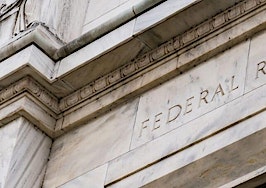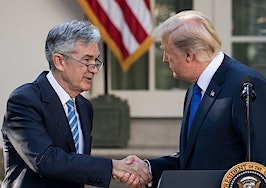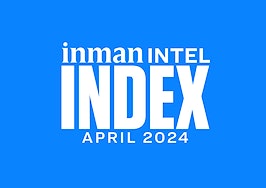How do you explain to mostly sensible homeowners and their Realtors that today‘s mortgage rate was set the night before by China’s daily fixing of the exchange rate of its yuan?
The net effect this week has been small since the new tariff announcement last Thursday but exciting along the way. Lowest-fee mortgages briefly fell as low as 3.75 percent, back to roughly 3.875 percent today, although Jumbos have risen above 4 percent. That disorder is a marker of uncertainty, as is the widening spread of mortgages above the 10-year T-note.
Before attempting explanations, keep one thing clear: nothing matters for interest rates now except U.S. tariffs and trade war. Nothing. New economic data will be seen as an effect of trade. And trade will bring its economic effects in two ways: Actual economic damage and a completely unpredictable White House.
Start with nomenclature. Out of historical custom, currency markets use two different notations for foreign currency values relative to the dollar. Most are quoted in dollar value: Pounds today down to $1.20 on Brexit fear, the Euro up to $1.12 on hopes that Germany will at last expand spending, and so on.
Hopelessly confusing to civilians, two notable currencies are quoted as the number of each per dollar. One dollar today will buy 1.05 yen. When that figure falls, the yen is strengthening — the dollar will buy fewer of them. Nitwits in the financial press describe yen-strengthening as a “move to safety,” which in the unique case of the yen is not so. Speculators can borrow near-infinite sums of yen at zero cost to buy other things on extreme leverage. When the world becomes frightened these borrowers race to sell their leveraged investments and pay back their yen loans, which makes the yen rise. Safety is in getting out, un-borrowing, not in owning yen.
The world is scared, leveraged bets off.
The second currency quoted to-the-dollar, not in dollars: China’s yuan. Unlike the yen, the yuan is only partially tradable and convertible in markets. In total government control, the yuan has one exchange rate inside China and another in its dinky offshore market.
China does not dare allow free trading for three reasons: It wants a low and stable yuan to facilitate exports; immense sums of savings would flee China and the yuan given the chance; and China does not have the foreign exchange (“forex”) reserves to “defend” the yuan.
If for any reason there is a run on any currency, “defense” is deployed by raising interest rates (high rates are a cash-magnet); or by using forex reserves to buy one’s own currency — that’s why China cannot sell its U.S. Treasury reserves to punish us — or by having your central bank print money to buy your own money.
It’s always tempting to cheapen your currency to facilitate exports (“devaluation”), but sometimes necessary. Most of Europe desperately needs to devalue versus the Germany-puffed euro. But devaluation runs several risks: Internal inflation, capital flight, and instantly increased cost of borrowing in any other currency, existing loans or new ones.
Now that all of that is clear :-), back to China and U.S. mortgage rates. China last fiddled with devaluation in 2015, and it took years to repair the damage, mostly by installing powerful limits on moving yuan outside the country. Its forex reserves had plunged from roughly $4.5 trillion to $3 trillion, where they remain. Given China’s export engine it should by now have vast forex reserves, but its banks require constant recapitalization to recover from bad loans to state industries, and more state capital to expand the export engine and infrastructure. (Hence also over-production and flat-to-falling global prices.)
After 2015, China held the yuan under 7.00 to the dollar, intentionally stronger than market pricing. Remember: just like the yen, down is up. China did so for three reasons: pride; trying not to annoy the U.S. and others by devaluing; and because it is a huge importer (oil, iron, copper…) and wants to keep input costs down.
The White House has increased pressure on China to end all of its misbehavior with nothing in return, and by early summer China made clear that it would slow-walk negotiations until what’s-his-name is gone, in 18 months or in 2024. Then last Thursday the new tariff announced to take effect September 1. Global markets flinched last Friday. China would react, but how?
Bloomberg TV in the evenings in the U.S. broadcasts from Sydney, Singapore and Hong Kong. Depending on your time zone, stay up late enough and you’ll catch the Asia market open, including China’s daily fix of the yuan value. Last Sunday night China pegged above 7.00/$ — devaluing, but only by small decimals. A signal, not a significant economic effect. That Sunday night global bonds plunged, pulling our mortgages (and stocks) down.
China’s fixings since have looked like this: 7.1265 per dollar, then up to 6.9683, down to 6.9996, 7.0039, and today trading 7.0624. In markets we are all Pavlov’s dogs, salivating when we hear his bell. We all know that these fixings are uniquely Chinese signals of its intentions to fight back against U.S. policy, but we don’t know the extent the retaliation to come, which is exactly what China wants.
China will not deal with this White House, no matter what it does. China may slowly devalue further to assist its total exports while reducing exports to the U.S. New data yesterday: China’s July exports to the U.S. fell 6.5 percent from 2018, but rose globally by 3.3 percent.
So, where’s the fire? Why the panic to buy bonds, and sudden central bank easing in New Zealand, India, Thailand, others soon? The German 10-year to minus-0.572 percent, Japan’s to minus-0.219 percent, beyond the control of the BOJ?
China’s redirected exports will in every case elbow someone else out of the way, another exporter or domestic producer — none of whom can quickly or perhaps ever take China’s place as exporter to the U.S. Among the great benefits of trade is specialization: low labor cost nations make cheaply products with high labor content, to the benefit of their citizens and customers. Sophisticated producers become more sophisticated, reducing price and adding quality. These chains have some narrow flexibility in competition, but not if they are disrupted altogether. The U.S. no longer has the machines that make the machines to produce inexpensive fabric, flat-screen TVs, or sneakers.
The net effect of trade war: A slower global economy. How much, how fast, how offset by easing central banks, what new tariffs, what retaliation?
Nobody knows.













